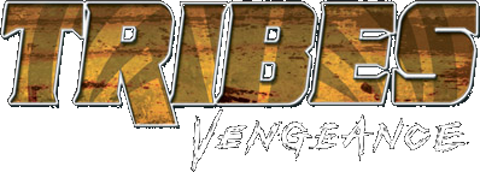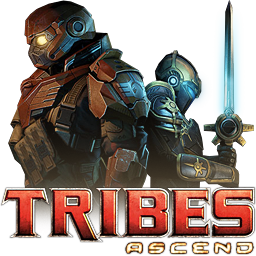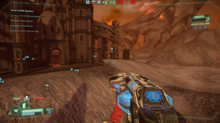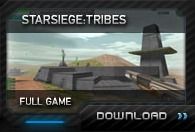
History[edit]
A sequel, Tribes 2, was released in March 2001. Sierra licensed the franchise to Irrational Games for a third installment,Tribes: Vengeance, which was released in October 2004.
Vivendi Universal released Tribes and Tribes 2 for free on May 4, 2004 on a DVD-ROM with Computer Gaming Worldmagazine and on FilePlanet, in order to promote the release Tribes: Vengeance.[2]
On July 16, 2007, Sierra Entertainment announced that they would cease online support of Tribes starting on August 16, 2007.[3] As of November 2007, the Sierra Master Server is no longer active, and has been replaced by multiple community-run Master Servers.[citation needed]
In March 2009, GarageGames announced they had purchased the Intellectual property and source code for Starsiege: Tribes and would be releasing it at PlayTribes.com through an update on their browser-based game service,InstantAction.[4] PlayTribes was available for play during the 2009 Penny Arcade Expo at InstantAction's display in the expo hall.[5]
On October 23, 2010, it was announced that Hi-Rez Studios were the new owners of the Tribes franchise, thus canceling development on PlayTribes.[6] The company released Tribes: Ascend in April 2012.
Gameplay[edit]
Tribes is a squad-based multiplayer online game with no single-player campaign; it is similar in this respect to the Team Fortress and Enemy Territory games. The story is set in the 40th century, after humanity has settled across the galaxies via jumpgates. Conflict has broken out between several factions of humans, the four largest of which are the Children of the Phoenix, Blood Eagle, Diamond Sword, and Starwolf. The first and largest descends from people isolated from the Great Human Empire during the jumpgate diaspora. The second is a force of imperial knights originally sent from the Empire to subdue them who have gone 'tribal' over time. The Diamond Sword and Starwolf are secondary, with innumerable other splinter tribes constantly fighting for territory. The player assumes the role of a warrior loyal to one of the four major tribes battling in the front lines of the conflict.
The battles take place on one of 40 maps. Most of the standard maps are outdoors environments in a variety of climates, from sunshine to snow and hail. In general, bases are scattered throughout the map depending on the gametype. The outdoor environments can extend for several kilometers.
There are five distinct "default" gametypes:
- Capture the flag (CTF) - Each team (up to eight, normally less than three on any given mission) has one or more bases and a single flag. Each team tries to take an opposing team's flag and touch it to their own, which "captures" the flag and awards the capturing team a point. If a flag carrier is killed, the flag is dropped; the flag can be picked up by a teammate to finish the capture, instantly returned to its base by a member of the flag's team, or returned after a certain interval of time. Stalemates often occur when multiple teams' flags are taken at the same time; a team's flag must be at its base to accomplish a "cap". Capture the Flag is a popular mode, with 75 percent of servers running this game type.[7]
- Deathmatch (DM) - It can be played with or without teams; in both cases, players must get the highest number of kills to win.
- Capture and hold (C&H) - Teams must seek out capturable bases or other assets, sometimes complete with turrets and stations, throughout the map. Points are given based on the amount of time an asset is "owned".
- Defend and destroy (D&D) - Players on a team must destroy certain items in an enemy's base before the enemy does the same to their base. Subsequent team-based First-person shooter games, however, did use variations of the concept (such as with Unreal Tournament and its "assault" game type). Defend and Destroy is the second-most popular game type.[7]
- Find and retrieve (F&R) - A number of flags are scattered across the mission area. Team members must find and bring them back to their base. The flags can be captured from the enemy as well. The team to capture all the flags wins.
- Multiple Team: Multiple teams must fight against each other to retain control of an objective or to capture the enemies' flag.
- Speedball/Paintball: Similar to capture the flag, Speedball, also known as Paintball, is a game setting in which you had paintball guns that where one hit kills, regardless of the gun used. The map was limited to custom set building in which both teams was put on different sides of the map. The first team to reach a certain number of flag captures, win, then the next round would start on another terrain.
- Open Call: Open Call isn't necessarily a game mode per se, but a collection of missions created by map makers after a contest held by Dynamix.[8]
Each player wears either light, medium or heavy armor. Heavier armors supply larger amounts of armor, energy, and ammunition. Different armor types support different weapons and equipment; for example, only the heavy armor supports the heavy mortar but only light armor supports the sniper rifle.[7] When damage is dealt to the player (by falling or being hurt by a weapon), armor is lost. Loss of all armor results in the player's death. After dying, the player respawns at the team's base (or somewhere in the field). Players also have an energy cell, which is drawn on for jetting, firing some kinds of weapons, and activating packs. The different armor types can be accessed at an inventory station.
There are various items of equipment usable by the players, including vehicles, eight weapons, and "Packs" which alter the abilities of the player. On some maps, bases include various defense mechanisms and other tools to assist the team: Generators, turrets, stations and sensors. Generators provide power to systems. Destroying them can disable an entire team's defense by deactivating turrets and stations. They are also among the objectives in the "Defend & Destroy" gametype. Turrets come in five varieties. They can all be destroyed by sustained fire and their shields can be drained by an ELF. Stations are where players get equipment or monitor the base. Sensors scan a radius for enemies and allow players to view troop movements in the PDA (Personal Digital Assistant). There are large and small varieties.
Weapons include the heavy mortar, sniper rifle, explosive disc launcher, short-range gatling gun, grenade launcher, blaster, plasma rifle and laser rifle. The heavy mortar is considered to be a good weapon for taking out base defenses from afar.[7] The sniper rifle is the only hitscan weapon, with the others firing relatively slow projectiles.[7]
The PDA is intended to provide information to commanders and give detailed information on the team's situation. Among other things, players can issue commands to teammates, view equipment status, monitor enemy activity (with sensors or hidden cameras), watch teammates in a miniature screen, and control turrets (although this must be done at a command station).

Setting[edit]
Set in the year 3941 of the fictional Earthsiege universe, Tribes 2 allows the user to play as a soldier in one of several factions (referred to in the game as tribes), namely the Children of the Phoenix, the Blood Eagle, the Diamond Sword, and the Starwolf. Players can also choose to play a rebelling human-created soldier/worker race called the BioDerms. None of the factions differ from each other in strengths or weaknesses, but each has a distinctive look and background story.
Gameplay[edit]
Tribes 2 is a multiplayer online game, designed for Internet or LAN play with up to 128 players (64 vs 64) or bots per match, although a small single-player tutorial mode is included. The game may be played from both first- and third-person perspectives. Each match takes place on an Earthsiege-themed map. The Tribes 2 engine, an early version of the Torque Game Engine, is capable of both indoor and outdoor maps, with expansive play areas. Player movement about the map may be on foot, using a jet pack, or in various ground and airborne vehicles as pilot, co-pilot, or passenger.
Each match is played according to one of a number of possible game modes, which dictate the rules of the match. These modes include capture the flag,deathmatch, rabbit-chase, and others. Players are free to choose their own role, and may deploy various items of weaponry, vehicles, and emplacements. Many of these items can be left unattended to operate automatically, or control may be assumed by players. Each player may also choose from three armor types (which trade off various abilities, e.g. weak but fast, or strong but slow), and a weapon and equipment loadout, which may be reconfigured at any time during a match.
The large variety of equipment and deployable items results in many opportunities for creative play and tactics, from pure combat to stealth. Tribes 2 gameplay makes extensive use of jet pack-powered flight, which adds a notable vertical element to combat. As such, playing style varies dramatically from player to player, and from moment to moment, but Tribes 2 gameplay may be generalized as being fast-paced three-dimensional combat over a wide playing area. Player vs player combat is a central element of Tribes 2 gameplay, even in team-based modes.

Gameplay[edit]
As a primarily first-person shooter, Tribes: Vengeance places the player in control of an infantry soldier in power armor. While the game is tailored for first-person shooting, the player can also toggle to a third-person view at any time. Additionally, there are multiple pilotable vehicles, which are restricted to third-person camera.
The game's most distinguishing features are the jetpacks and "skis" offered on all variants of the power armor. Jetpacks allow the player to fly for short periods of time, using the player's energy meter. This energy regenerates whenever the jetpack is not active. Skiing may be activated any time the player is on foot and does not cost energy; this switches the player to a frictionless ground-travel mode, allowing the player to slide very rapidly down slopes and (with sufficient speed before activating the skis) across flat terrain. Skiing up a slope will cause the player to slow due to gravity.
Combat occurs primarily with ranged weapons, including bullet and explosive projectile firearms. Each character, vehicle, and machine has hit points. Anything with hit points may be repaired by "repair packs"; infantry may also pick up medkits dropped by other infantry upon death. The game offers three classes of armor: light, medium, and heavy. Heavier armor offers more hit points and ammunition but slower movement.
The player has three weapon slots, grenades, and a utility slot; the utility slot holds items such as repair packs, speed packs, energy packs and deployables like repair stations, turrets and inventory stations.

http://www.tribesascendwiki.com/Tribes_Ascend_Wiki
Gameplay[edit]
Loadouts and Classes[edit]
Tribes: Ascend features a class-based loadout system. Each loadout specifies what type of armor the player has, along with what weapons and items they carry. Each loadout supports two in-hand weapons, a set of belt items such as grenades or mines and a pack. There are three possible sizes of armor to choose: light, medium and heavy, with three loadouts in each weight group (for a total of nine). Players can select which loadout to use either when first joining a game, respawning, or at an inventory station. Loadouts may be acquired either through an upfront payment, or through playing the game and earningexperience points, which can be used to purchase classes, weapons, perks, and upgrades.[6] Paid-for loadouts are available to the user immediately, while those who unlock them through playtime have a much longer wait. Upgrades to armor, weapons and perks are unlocked based on how much you use them in-game, but can also be purchased by experience points. Players are given three free classes: the Pathfinder, Soldier, and Juggernaut, when they first start playing the game, each wearing light, medium and heavy armor respectively.[7]
Hi-Rez also sells cosmetic items such as player skins, along with boosters that allow players to gain experience points at a faster rate. Players earn in-match credits during matches for killing enemies, repairing structures or capturing objectives. Credits are then used to buy vehicles, supply drops, Tactical and Orbital strikes and base upgrades.[8]
On February 22, 2012, the game entered open beta. Arena 5v5 was added and Rabbit was disabled during this phase of the beta, though would later return as a private server option.[9]




